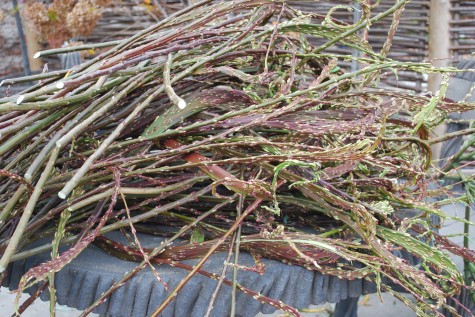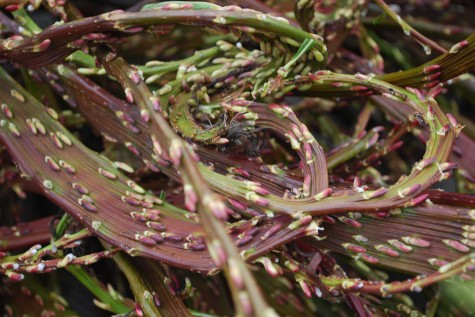 My November garden is radically different and edited in character from what I see in the summer-but characters there are. The willows are coming into their own. I wouldn’t give a nickel for a willow in the summer-save the dwarf blue artic willow. Its graceful branches almost always in motion can recreate the feeling of a meadow in a small space. Other willows are coarse in leaf and ungainly in habit-in a word, park-grade. Should you have acres such that the willows can be planted comfortably far away in your park, fine. There are too many other more civilized choices for my small garden to give over space to this group. In November, I rue my rule. The cut branches of salix sachaliensis “sekka” pictured above would not make you rush to your local nursery to buy one, but as with most willows, their bold branches shine now. When the willow leaves finally drop, I kick myself for not having an entire hedge of it in the ground.
My November garden is radically different and edited in character from what I see in the summer-but characters there are. The willows are coming into their own. I wouldn’t give a nickel for a willow in the summer-save the dwarf blue artic willow. Its graceful branches almost always in motion can recreate the feeling of a meadow in a small space. Other willows are coarse in leaf and ungainly in habit-in a word, park-grade. Should you have acres such that the willows can be planted comfortably far away in your park, fine. There are too many other more civilized choices for my small garden to give over space to this group. In November, I rue my rule. The cut branches of salix sachaliensis “sekka” pictured above would not make you rush to your local nursery to buy one, but as with most willows, their bold branches shine now. When the willow leaves finally drop, I kick myself for not having an entire hedge of it in the ground.
 Commonly known as fantail willow, this shrubby plant is known for its fasciated stems. OK-I will cover the science as fast as I can. Meristem cells, from whence all parts of the plant grow, are dome shaped; they produce the cylindrical shapes we know as branches. Either from mutation, or some other force not clearly understood, some meristem cells flatten out, and elongate, producing wide flat stems that may curl in a most unusual way. These bold branches are gorgeous in the garden, and in fall and winter arrangements.
Commonly known as fantail willow, this shrubby plant is known for its fasciated stems. OK-I will cover the science as fast as I can. Meristem cells, from whence all parts of the plant grow, are dome shaped; they produce the cylindrical shapes we know as branches. Either from mutation, or some other force not clearly understood, some meristem cells flatten out, and elongate, producing wide flat stems that may curl in a most unusual way. These bold branches are gorgeous in the garden, and in fall and winter arrangements.
 Some floral supply places carry dried fantail willow, but I prize the the fresh cut stems. Each branch colors up individually in the fall in shades of red, green and brown. The cut branches retain their color outdoors in cold weather a very long time; they make a striking centerpiece in holiday and winter pots, in wreaths and door swags.
Some floral supply places carry dried fantail willow, but I prize the the fresh cut stems. Each branch colors up individually in the fall in shades of red, green and brown. The cut branches retain their color outdoors in cold weather a very long time; they make a striking centerpiece in holiday and winter pots, in wreaths and door swags.
 The grooves and furrows, a direct result of the process of fasciation, make for a very bold texture. Note the elongated the leaf buds set for spring. Fasciation can occur in many plants-I have seen two-headed dandelions, and thick flat stems of bulb lilies with their bouffant hairdo of flowers clustered at the top. Some plants may produce stems like this intermittently-these are called witches brooms, after the look of that proliferation of branches. Some witches brooms are cut, and propagated from cuttings. Certain dwarf conifers with very congested and odd branching patterns of questionable appeal come to market via a chance fasciation.
The grooves and furrows, a direct result of the process of fasciation, make for a very bold texture. Note the elongated the leaf buds set for spring. Fasciation can occur in many plants-I have seen two-headed dandelions, and thick flat stems of bulb lilies with their bouffant hairdo of flowers clustered at the top. Some plants may produce stems like this intermittently-these are called witches brooms, after the look of that proliferation of branches. Some witches brooms are cut, and propagated from cuttings. Certain dwarf conifers with very congested and odd branching patterns of questionable appeal come to market via a chance fasciation.
 Color can be tough to come by this time of year where I live. I love the natural greys, browns and blacks common to the season, but I so appreciate robust color in a landscape that has by and large gone dormant.
Color can be tough to come by this time of year where I live. I love the natural greys, browns and blacks common to the season, but I so appreciate robust color in a landscape that has by and large gone dormant.

How these branches curl, swirl and swoop are as striking as their color. The remains of my ornamental grasses and beech ferns are rigidly spiky. Everywhere I look, I see sticks and more sticks.

Their sculptural appeal aside, they are visually so lively. I have trouble keeping them in stock this time of year; these bold branches are a celebration of the late fall season.
Hello —
Just wanted to say I have been going through your blg and have been enjoying it very much. I spent 22 years in the lawn & garden biz in my home state of CT and looking at your lovely shop made me miss my old job so much, especially custom decorating Christmas wreaths and then planting custom containers several times during the year. When I moved to Indiana 8 years ago I was unable to get a job in the same field at the rate of pay I needed to survive so I now work an office job and my activities are now confined to our home, alas!
Your blog is wonderful—just wanted to stop and say so!
Regards,
Val
Thanks for writing Val.